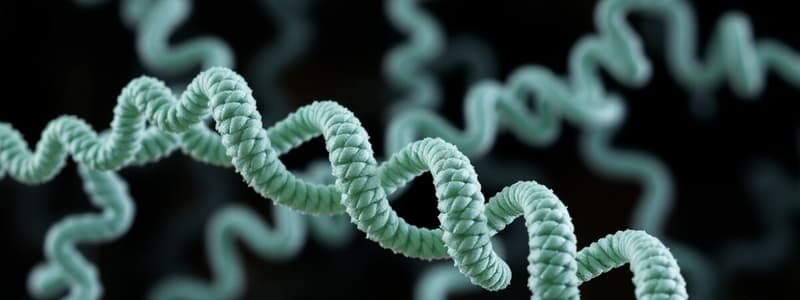Podcast
Questions and Answers
What is the role of RNA polymerase in transcription?
What is the role of RNA polymerase in transcription?
- RNA polymerase binds to the tRNA molecule and brings amino acids to the ribosomes.
- RNA polymerase breaks the hydrogen bonds between the DNA bases. (correct)
- RNA polymerase joins the mRNA nucleotides together to form the mRNA molecule.
- RNA polymerase helps move the ribosome along the mRNA molecule during translation.
During transcription, what happens to the DNA molecule?
During transcription, what happens to the DNA molecule?
- The DNA molecule is completely destroyed and replaced with an mRNA molecule.
- The DNA molecule is replicated to produce two identical DNA molecules.
- The DNA molecule is temporarily unzipped, and one strand is used as a template for mRNA synthesis. (correct)
- The DNA molecule remains unchanged and is not involved in the process of transcription.
What is the difference between a codon and an anticodon?
What is the difference between a codon and an anticodon?
- Codons and anticodons are both sequences of three bases on tRNA.
- A codon is a sequence of three bases on mRNA, while an anticodon is a sequence of three bases on tRNA. (correct)
- Codons and anticodons are both sequences of three bases on mRNA.
- A codon is a sequence of three bases on tRNA, while an anticodon is a sequence of three bases on mRNA.
Which of the following is NOT a difference between DNA and RNA?
Which of the following is NOT a difference between DNA and RNA?
What is the function of the ribosome in protein synthesis?
What is the function of the ribosome in protein synthesis?
What is the role of tRNA in translation?
What is the role of tRNA in translation?
Which of these is the correct order for the steps of protein synthesis?
Which of these is the correct order for the steps of protein synthesis?
What is the significance of the start codon AUG in translation?
What is the significance of the start codon AUG in translation?
Flashcards
Protein Synthesis
Protein Synthesis
The process of making proteins from genes, involving transcription and translation.
Transcription
Transcription
The process of creating mRNA from a DNA template in the nucleus.
Translation
Translation
The process of converting mRNA into a protein at the ribosome.
mRNA
mRNA
Signup and view all the flashcards
Codon
Codon
Signup and view all the flashcards
tRNA
tRNA
Signup and view all the flashcards
Anticodon
Anticodon
Signup and view all the flashcards
Peptide Bond
Peptide Bond
Signup and view all the flashcards
Study Notes
-
mRNA is created from DNA.
-
This process takes place in the cell nucleus.
-
DNA unzips, and RNA polymerasProtein Synthesis Overview
- Protein synthesis is a two-part process: transcription and translation.
- Transcription happens in the nucleus and translation occurs at the ribosomes.
- The process converts DNA information into proteins.
- Learning the steps is crucial to understanding how cells synthesize proteins.
- Be able to contrast the locations of transcription and translation.
- Describe the steps involved in transcription and translation if provided with a DNA strand.
- Contrast DNA with RNA.
Transcription
- e breaks hydrogen bonds between bases.
-
Free-floating RNA nucleotides attach to DNA bases on one side of the molecule.
-
RNA polymerases (enzymes) read the DNA code to guide transcription.
-
RNA uses uracil instead of thymine.
-
Covalent bonds form between sugars and phosphates on the mRNA.
-
The mRNA then detaches from the DNA strand.
Translation
- mRNA is used to make proteins.
- This process happens at the ribosomes.
- Amino acids are brought to the ribosome by tRNA.
- tRNA anticodons pair with mRNA codons.
- Amino acids are joined together by peptide bonds to create a protein chain (polypeptide).
- Proteins are made from a series of amino acids.
- Three mRNA nucleotides (or bases) form a codon.
- Three tRNA nucleotides (or bases) form an anticodon.
- Three bases code for one amino acid.
- Start codons (e.g., AUG) signal the beginning of translation, while stop codons (e.g., UAA, UAG, UGA) signal translation's end.
- Anticodons are specific; each tRNA carries only one specific amino acid.
DNA vs RNA
- DNA contains the nucleotide thymine, while RNA contains uracil.
- DNA is double-stranded; RNA is single-stranded.
- DNA has deoxyribose sugar; RNA has ribose sugar.
- DNA stays in the nucleus; RNA travels between the nucleus and cytoplasm.
- DNA has only one type; mRNA, tRNA, and rRNA are the three types of RNA.
Importance of RNA
- mRNA carries the genetic code from DNA to the ribosomes.
- tRNA brings amino acids to the ribosomes, which are important for making proteins.
- Information travels from DNA to RNA to proteins.
Studying That Suits You
Use AI to generate personalized quizzes and flashcards to suit your learning preferences.




